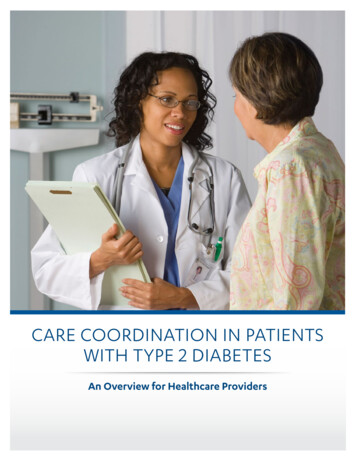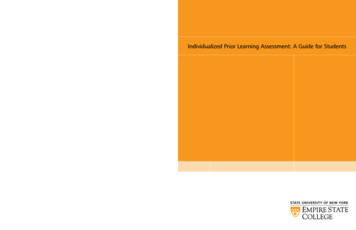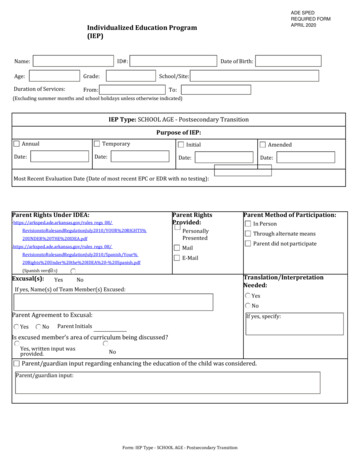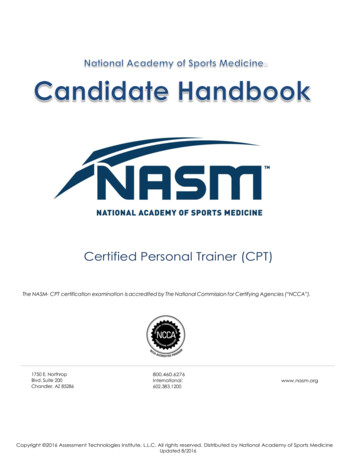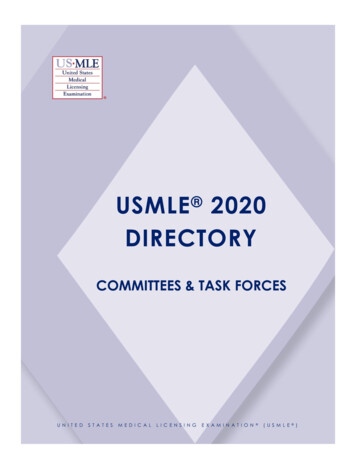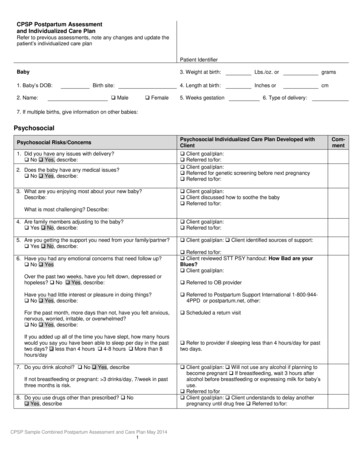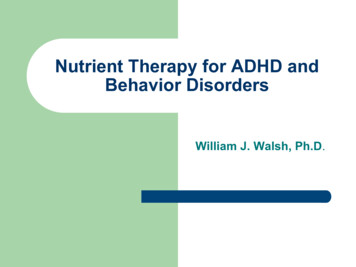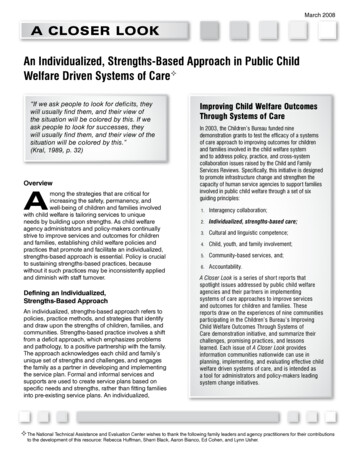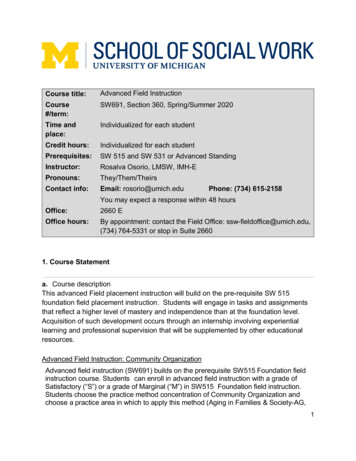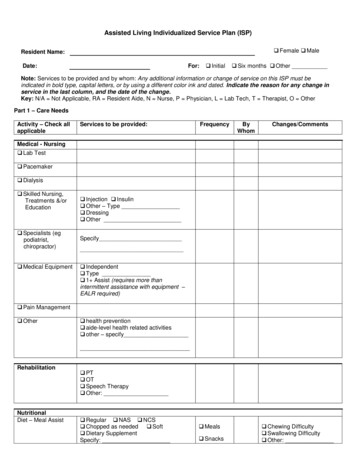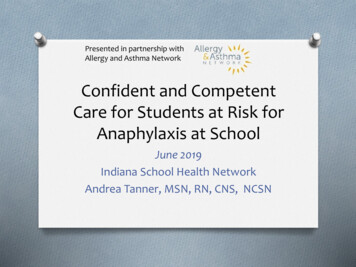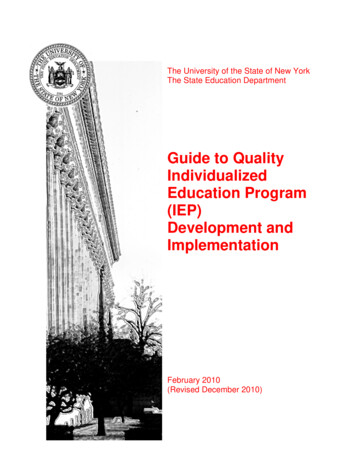
Transcription
The University of the State of New YorkThe State Education DepartmentGuide to QualityIndividualizedEducation Program(IEP)Development andImplementationFebruary 2010(Revised December 2010)
THE UNIVERSITY OF THE STATE OF NEW YORKRegents of The UniversityMERRYL H. TISCH, Chancellor, B.A., M.A., Ed.D. .MILTON L. COFIELD, Vice Chancellor, B.S., M.B.A., Ph.D. .ROBERT M. BENNETT, Chancellor Emeritus, B.A., M.S. .SAUL B. COHEN, B.A., M.A., Ph.D. .JAMES C. DAWSON, A.A., B.A., M.S., Ph.D. .ANTHONY S. BOTTAR, B.A., J.D. .GERALDINE D. CHAPEY, B.A., M.A., Ed.D. .HARRY PHILLIPS, 3rd, B.A., M.S.F.S. .JOSEPH E. BOWMAN, JR., B.A., M.L.S., M.A., M.Ed., Ed.D.JAMES R. TALLON, JR., B.A., M.A. .ROGER TILLES, B.A., J.D. .KAREN BROOKS HOPKINS, B.A., M.F.A. .CHARLES R. BENDIT, B.A. .BETTY A. ROSA, B.A., M.S. in Ed., M.S. in Ed., M.Ed., Ed.D. .LESTER W. YOUNG, JR., B.S., M.S., Ed. D. .CHRISTINE D. CEA, B.A., M.A., Ph.D. .WADE S. NORWOOD, B.A. .New Belle HarborHartsdaleAlbanyBinghamtonGreat NeckBrooklynManhattanBronxOakland GardensStaten IslandRochesterCommissioner of EducationPresident of The University of the State of New YorkDAVID M. STEINERAssociate CommissionerOffice of Special EducationREBECCA H. CORTStatewide Coordinator for Special EducationJAMES P. DELORENZOThe State Education Department does not discriminate on the basis of age, color, religion, creed, disability, maritalstatus, veteran status, national origin, race, gender, genetic predisposition or carrier status, or sexual orientation in itseducational programs, services and activities. Portions of this publication can be made available in a variety offormats, including braille, large print or audio tape, upon request. Inquiries concerning this policy of nondiscriminationshould be directed to the Department’s Office for Diversity, Ethics, and Access, Room 530, Education Building,Albany, NY 12234.
Guide to Quality Individualized Education Program (IEP)Development and ImplementationFebruary 2010Revised December 2010Table of ContentsPageIntroduction . 1Developing IEPs Linked to the Standards . 2Overview . 4Individualized Education Program (IEP) Development. 16IEP Identifying Information . 17Present Levels of Performance and Individual Needs. 18Measurable Postsecondary Goals and Transition Needs. 26Annual Goals, Short-Term Instructional Objectives and/or Benchmarks. 30Reporting Progress to Parents . 36Recommended Special Education Programs and Services (Revised 12/10) . 38Testing Accommodations . 47Coordinated Set of Transition Activities (School to Post-School) . 49Participation in State and District-wide Assessments. 53Participation with Students without Disabilities. 54Transportation . 55Placement Recommendation . 57IEP Implementation . 60Attachment 1: Committee on Preschool Special Education, CommitteeSpecial Education, Subcommittee on Special EducationAttachment 2: Consideration of Special Factorson
INTRODUCTIONResearch and experience has shown that to improve results for students with disabilities,schools must: have high expectations for students with disabilities; meet the student’s needs to enable the student to access, participate and progress inthe general education curriculum to the maximum extent possible; ensure that parents have meaningful opportunities to participate in the development,review and revision of the individualized education program (IEP); ensure that families have meaningful opportunities to participate in the education oftheir children at school and at home; ensure that special education is a service, rather than a place where students are sent; provide appropriate special education services and supplementary supports andservices in the general education classroom, whenever appropriate; provide effective systems of school-wide, classroom, small group and individualizedsystems of behavior supports; ensure that all those who work with students with disabilities have the skills andknowledge necessary to help such students to meet academic and functional goals; prepare students for their transition to adult living, working and learning to leadproductive independent adult lives to the maximum extent possible; provide high quality research-based instruction and supports; and focus resources on teaching and learning.The IEP is the cornerstone of the special education process for each individual student. Itis the tool to document how one student’s special needs related to his/her disability will bemet within the context of an educational environment. This guidance document providesimportant information for Committees on Preschool Special Education (CPSE) andCommittees on Special Education (CSE) 1 in developing IEPs that are reasonablycalculated to result in educational benefit to a student.1References to the CSE throughout this document include the Subcommittee, unless otherwise specified.February 2010 (Revised December 2010)1
DEVELOPING IEPS LINKED TO THE STANDARDS"The New York State Standards apply to all students, regardless of their experientialbackground, capabilities, developmental learning differences, interests or ambitions.There are multiple pathways to learn effectively, participate meaningfully and worktowards attaining the curricular standards. Students with a wide range of abilities maypursue multiple pathways to learn effectively, participate meaningfully and work towardattaining the curricular standards." (Learning Standards for English-Language Arts, NewYork State Education Department, March 1996).The New York State Learning Standards include learning standards, performanceindicators and sample tasks a student is expected to know or demonstrate at differentlevels (alternate, elementary, intermediate and commencement). Standards serve as thebasis for developing instructional curriculum.In developing a student's IEP, it is the responsibility of the Committee to recommend goalsand services that will assist the student to be involved and progress in the generaleducation curriculum (or for preschool students, in appropriate activities). This means thatmembers of a Committee will need to consider both the State's learning standards as wellas the school-based instructional curriculum, which should be aligned to the State’slearning standards. They will need to know the expectations of the general educationclassroom for the corresponding age of the student both in terms of what learning isexpected (general curriculum) as well as how the students are expected toaccess/demonstrate that learning. This information will assist the Committee indetermining if the student needs adaptations, accommodations, or modifications to thegeneral curriculum for all or part of his/her learning. This is one reason it is essential thatthe student's general education teacher(s) participate in the Committee meetings and forthe school district representative to be knowledgeable about the general educationcurriculum.To develop IEPs that are linked to the standards, the Committee should:1. Review the content as well as the expectations for how the student will learn ordemonstrate knowledge and skill in the content areas.2. Identify the strengths and challenges for the student in relation to those expectations inthe present levels of performance section of the IEP.3. Identify how a student’s needs are linked to the general curriculum (e.g., a student'sdifficulty with visual processing may affect graphing skills required to achieve the mathstandards).4. Identify the goals that the student will be expected to achieve in one year and, whenappropriate, short-term instructional objectives or benchmarks that are theintermediate steps to reach those annual goals). Standard-based goals do not meanthat a student’s goals and objectives in an IEP are a re-statement of a standard or acurriculum goal in a specific content area, but rather are a statement that reflects thenecessary learning that will lead to attainment of the standard. For example, a studentmay have goals to acquire essential learning strategies (e.g., mnemonics, selfquestioning, paraphrasing and summarizing) that will help him or her better meet theexpectations around how to learn the content.February 2010 (Revised December 2010)2
5. Identify the special education services, including the adaptations, accommodations, ormodifications to the general curriculum, and/or instructional environment andmaterials, as needed by the student to reach those standards.THE IEP AS THE CORNERSTONE OF THE SPECIAL EDUCATION PROCESSThe IEP is a strategic planning document that should be far reaching in its impact. An IEPidentifies a student’s unique needs and how the school will strategically address thoseneeds. IEPs identify how specially designed instruction will be provided in the context ofsupporting students in general education curriculum and in reaching the same learningstandards as nondisabled students. IEPs guide how the special education resources of aschool will be configured to meet the needs of the students with disabilities in that school.IEPs identify how students will be incrementally prepared for adult living. IEPs also providean important accountability tool for school personnel, students and parents. By measuringstudents’ progress toward goals and objectives, schools should use IEPs to determine ifthey have appropriately configured how they use their resources to reach the desiredoutcomes for students with disabilities.February 2010 (Revised December 2010)3
OVERVIEWThe Individualized Education Program (IEP)An IEP is a written statement for a student with a disability that is developed, reviewed andrevised by a Committee on Special Education (CSE), Subcommittee on Special Educationor Committee on Preschool Special Education (CPSE). The IEP is the tool that ensures astudent with a disability has access to the general education curriculum and is provided theappropriate learning opportunities, accommodations, adaptations, specialized services andsupports needed for the student to progress towards achieving the learning standards andto meet his or her unique needs related to the disability. Each student with a disabilitymust have an IEP in effect by the beginning of each school year. Federal and State lawsand regulations specify the information that must be documented in each student’s IEP. InNew York State (NYS), IEPs developed for the 2011-12 school year and thereafter, mustbe on a form prescribed by the Commissioner of Education.Who develops the IEP?An IEP must be initially developed and annually reviewed and, if appropriate, revised bythe CSE, Subcommittee on Special Education or CPSE (hereinafter referred to as theCommittee). The Committee is required to include certain individuals who know thestudent and his or her unique needs and who can commit the resources of the school toaddress the student’s needs.To develop an appropriate IEP for the student, a group of individuals with knowledge andexpertise about the student, curriculum and resources of the school must considerindividual evaluation information and reach decisions in an effective and efficient manner.Information about the student’s strengths, interests and unique needs gathered fromparents, teachers, the student, related service providers, evaluations and observations arethe foundation upon which to build a program that will result in effective instruction andstudent achievement. Each member of the multidisciplinary team that makes up theCommittee brings information and a unique perspective to the discussion of the student’sneeds and has an important role and responsibility to contribute to the discussion and therecommendations for the student.Each Committee has a chairperson who has certain responsibilities under the law andregulations. The school district representative must serve as the chairperson of theCommittee. The required members of the Committee include the following:STUDENTWhenever appropriate, the student should be invited to participatein the Committee meetings. It is the student, after all, who will bemost affected by the recommendations of the Committee. Theconcerns, interests and recommendations of the student need tobe considered. An IEP that builds on the strengths of the studentand includes recommendations that the student can support ismore likely to result in successful outcomes for the student. Thedecision to invite the student should be discussed with thestudent’s parent(s) to determine if the student’s attendance at theFebruary 2010 (Revised December 2010)4
meeting will be helpful in developing the IEP and/or directlybeneficial to the student. If the purpose of the meeting is toconsider the postsecondary goals for the student and transitionservices needed to assist the student in reaching those goals, thestudent must be invited. If the student does not attend, the districtmust take steps to ensure that the student's preferences andinterests are considered.PARENTS OF THESTUDENTAs Committee members, the student's parents or guardianparticipate in the development, review and revision of their child’sIEP. Parents are the constant individuals on the Committee fromyear to year for that student. They bring a history as well ascurrent information on their child’s strengths and needs and theirconcerns and ideas for enhancing their child’s education. Parentsbring information on what expectations and hopes and dreamsthey have for their child, and often can speak to those approachesthat have been successful and/or unsuccessful for their child.They can also provide information on their child’s interests thatcan be used to motivate the child’s learning, the skills that thechild shows at home and in other settings and whether skillslearned in school are being demonstrated elsewhere. Theconcerns of the parent for the education of their child must beconsidered in the IEP development process.REGULAREDUCATIONTEACHER OF THESTUDENTWhenever the child is or may be participating in the generaleducation environment, at least one regular education teacher ofthe child must participate as a member of the Committee. Theregular education teacher of the student has knowledge of theschool’s general education curriculum requirements and helps interventions, instructional strategies, supplementary aids andservices, program modifications and supports for school personnelfor and on behalf of the student that are necessary for the studentto participate to the fullest extent possible in general educationcurriculum and classes. While only one regular education teacherof the student is required to attend the meeting, the Committee isencouraged to seek the input of the student’s other regulareducation teachers who will not be attending the Committeemeeting.INDIVIDUAL WHO CAN At least one individual must participate in the Committee meetingwho can interpret evaluation information so that the instructionalINTERPRET THEimplications of those evaluations are understood and consideredINSTRUCTIONALin the IEP development process. This individual may, asIMPLICATIONS OFappropriate to the evaluations to be discussed, be a member ofTHE EVALUATIONthe Committee who is also serving as the regular educationteacher, special education teacher or special education provider,(e.g., related service provider), school psychologist, representativeFebruary 2010 (Revised December 2010)5
of the school district or a person having knowledge or specialexpertise regarding the student when such member is determinedby the school district to have the knowledge and expertise to fulfillthis role on the Committee.SCHOOL DISTRICTREPRESENTATIVEThe school district representative must be someone who isqualified to provide or supervise special education and who isknowledgeable about the general education curriculum and theavailability of resources of the district. This individual bringsknowledge of the continuum of special education supports andservices and should have the authority to commit the resources ofthe school and to ensure that whatever services are set out in theIEP will be provided.The individual who meets these qualifications may also be thesame individual appointed as the regular education teacher,special education teacher or special education provider of thestudent or the school psychologist on the Committee. The schooldistrict representative on the Committee must serve as thechairperson of the Committee.INDIVIDUALS WITHKNOWLEDGE ORSPECIAL EXPERTISEABOUT THE STUDENTIn addition to the other required members, parents and schoolpersonnel have discretion to invite other individuals who haveknowledge or special expertise regarding the student. This isimportant to ensure that the Committee includes the input of thosepersons that can add to the discussion of the student’s needs andrecommendations for supports and services. The determination ofthe knowledge or special expertise of any such individual is madeby the party (parents or school) who invited the individual to themeeting. When these individuals attend the meeting, theyparticipate as Committee members for the student.SPECIAL EDUCATIONTEACHER, ORRELATED SERVICEPROVIDER, OF THESTUDENTNot less than one special education teacher of the student, or ifappropriate, not less than one special education provider of thestudent must participate in the Committee meetings. If the studentis being considered for initial provision of special education, thisindividual must be a teacher qualified to provide special educationin the type of program in which the student may be placed and bethe teacher likely to implement the student’s IEP. The student’sspecial education teacher provides information on the speciallydesigned instruction needed to address the student’s uniqueneeds.SCHOOLPSYCHOLOGISTA school psychologist is a member of the CSE, and under certaincircumstances, the Subcommittee. (The school psychologist is nota required member of the CPSE.) This individual contributes to anunderstanding of the individual evaluations conducted on theFebruary 2010 (Revised December 2010)6
student, assists to identify the positive behavioral interventionsupports and strategies needed by the student, assists to planschool programs to meet the student’s needs and to identify, planand manage any psychological services the student might need.ADDITIONAL PARENT In addition to the parent of the student, another parent of a studentwith a disability must participate in meetings of the CSE andMEMBERCPSE, except when the parents of the student request, in writing,that the additional parent member not participate or when theparents and school district agree, in writing, that the participationof the additional parent member is not necessary. For the CSE,the additional parent member must be a parent of a student with adisability residing in the school district or a neighboring schooldistrict, provided that the additional parent member may be theparent of a student who has been declassified within a period notto exceed five years or the parent of a student who has graduatedwithin a period not to exceed five years., For the CPSE, theadditional parent member must be a parent of a child with adisability residing in the school district or a neighboring schooldistrict and whose child is enrolled in a preschool or elementarylevel education program. The additional parent member may notbe employed by or under contract with the school districts. Theadditional parent member is not a required member of aSubcommittee.The additional parent member can provide important support andinformation to the parents of the student during the meeting and,in addition to the student’s parents, participates in the discussionsand decision making from the perspective of a parent of a studentwith a disability.SCHOOL PHYSICIANA school physician, if specifically requested in writing by theparent or school district at least 72 hours before the meeting, is arequired member of the CSE.OTHER AGENCYWhen the purpose of the meeting is to discuss transition services,a representative of any participating agency likely to beresponsible for providing or paying for transition services must beinvited to the meeting to the extent appropriate and with theconsent of the student's parent (or the student who is 18 years ofage or older). Written consent is needed because personallyconfidential information about a student will be shared at theCommittee meeting. If an agency invited to send a representativeto a meeting does not attend, the district must take steps toinvolve the other agency in the planning of any transition services.REPRESENTATIVESWhen a student is or may be attending an approved private schoolor facility, a representative of that school or facility must be invitedFebruary 2010 (Revised December 2010)7
to participate in the student’s Committee meetings. This is also thecase when a student is attending an education program operatedby another State department or agency (e.g., Office of MentalHealth, Office of Children and Family Services). If the privateschool or facility representative cannot attend, the school districtmust use other methods to ensure participation by the privateschool or facility, including individual or conference telephonecalls.For CPSE meetings, a representative of the municipality must beinvited, but if that representative does not attend, the meeting canlegally proceed. For students transitioning from early intervention(EI) programs and services to the CPSE, an EI service coordinatoror other appropriate representative of the EI system must beinvited at the request of the parent.ATTENDANCE NOTNECESSARYThe parent and the school district may agree in writing that theattendance of one or more of the Committee members is notnecessary for all or a portion of a particular Committee meetingbecause that individual's area of service will not be discussed ormodified at the meeting. The regulations for these procedures areprovided in Attachment 1.EXCUSAL OFCOMMITTEEMEMBERSIf a particular Committee member's area of service will bediscussed or modified at a meeting, but the individual is not ableto participate in the meeting, the parent and the district mayconsent in writing to excuse the individual from all or a portion ofthe meeting. In this case, the Committee member must haveprovided the Committee members with a written report. Theregulations for these procedures are provided in Attachment 1.Attachment 1 provides further information on the required members of these Committees.February 2010 (Revised December 2010)8
STEPS TO DEVELOPING AND IMPLEMENTING AN IEPThe IEP needs to be developed in a particular sequence. The information considered anddiscussed in each step provides the basis for the next step in the process.Step 1:Obtain and consider evaluation informationEvaluation information must be obtained in all areas of the student’sdisability or suspected disability. Evaluations need to identify and provideinstructionally relevant information as to the unique needs of the student,current functioning, cognitive, physical, developmental and behavioralfactors that affect learning and how the disability affects the student’sparticipation and progress in the general education curriculum and in generaleducation classes (or, for preschool students with disabilities, participation inage appropriate activities).Before a student is identified as needing special education services, theCommittee must ensure that the appropriateness of the resources of thegeneral education program, including but not limited to academicinterventions services, has been considered.Step 2:Determine eligibility for special education servicesThe Committee must review the evaluation information to determine if thestudent has a disability that requires special education services. ACommittee may not determine that a student needs special educationservices if the determinant factor is:y lack of appropriate instruction in reading, including explicit andsystematic instruction in phonemic awareness, phonics, vocabularydevelopment, reading fluency (including oral reading skills) and readingcomprehension strategies;y lack of appropriate instruction in math; ory limited English proficiency.If the Committee determines that the student is eligible for special educationservices, it must identify the student’s disability classification. For school-agestudents, one of the following disabilities must be identified: autism,deafness, deaf-blindness, emotional disturbance, hearing impairment,intellectual disability, learning disability, multiple disabilities, orthopedicimpairment, other health impairment, speech or language impairment,traumatic brain injury or visual impairment including blindness.Each 3 - 4 year old in need of special education is identified as a "preschoolstudent with a disability." In making this determination, the CPSE mustdetermine if the preschool student exhibits a significant delay or disorder inone or more functional areas or meets the criteria for a disabilityclassification of autism, deafness, deaf/blindness, hearing impairment,orthopedic impairment, other health-impaired, traumatic brain injury or visualimpairment including blindness.February 2010 (Revised December 2010)9
Step 3:Identify the student’s present levels of performance and indicate theindividual needs of the student according to each of four need areas:y academic achievement, functional performance and learningcharacteristics;y social development;y physical development; andy management needs.At the Committee meeting, the student’s present skills, strengths andindividual needs must be discussed and documented. This includes how thestudent’s disability affects his or her participation and progress in the generaleducation curriculum (or for preschool students, participation in appropriateactivities), consideration of specific student strengths and needs andconcerns of the parents for enhancing the education of their child.Consideration of special factorsThe Committee must include a statement in the IEP if, in considering thespecial factors of behavior, limited English proficiency, blind or visualimpairment, communication needs and/or assistive technology requirements,the Committee has determined a student needs a particular device orservice (including an intervention, accommodation or other programmodification) in order for the student to receive a free appropriate publiceducation.Attachment 2 provides examples of guiding questions that may be used by aCommittee to determine whether a student needs such an intervention,accommodation or program modification to address one of these specialconsiderations.Step 4:Identify the measurable postsecondary goals and transition needs,including courses of study, of the studentBeginning not later than the first IEP to be in effect when the student is age15 (and at a younger age, if determined appropriate) and updated annually,the IEP must include:y appropriate measurable postsecondary goals based upon ageappropriate transition assessments relating to training, education,employment and, where appropriate, independent living skills; andy a statement of transition service needs that focuses on the student’scourses of study, taking into account the student’s strengths,preferences and interests, as they relate to transition from school topost-school activities.Step 5:Set realistic and measurable annual goals for the studentAfter determining and discussing the student's present levels of performanceand, as appropriate, the student's measurable post-secondary goals, theCommittee must make a recommendation as to the measurable annualgoals that the student can realistically reach in the year in which the IEP willbe in effect. For each annual goal, the IEP must indicate the evaluativecriteria (the measure us
review and revision of the individualized education program (IEP); ensure that families have meaningful opportunities to participate in the education of their children at school and at home; ensure that special education is a service, rather than a place where students are sent;
